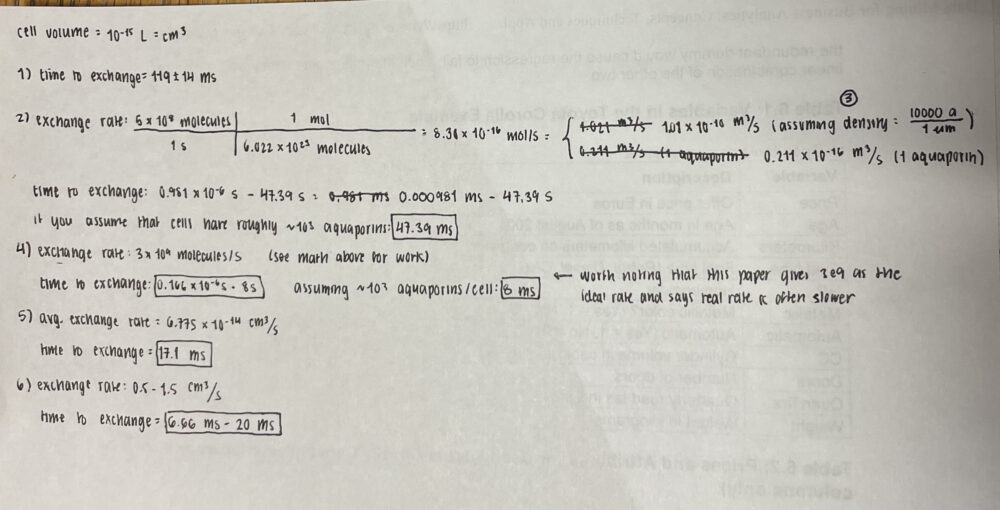
aquaporin adventures by Alice L. '24
a livestream of my brain while working on my urop
The Problem: A reviewer went “You guys did things while assuming that cells exchange their water in the matter of milliseconds. Proof?”
The Science Problem: How fast does water get in/out of cells?
1:31 am:
I’m going to work on this for half an hour
Thought 1: Rate of water swooshing around = number of aquaporins * average rate of water through an aquaporin
1:33 am:
this paper tells me cells have “up to 10,000 [aquaporins] per square micron.”
which is kind of vague (what do you mean, up to? Can I get an actual distribution?) but I’m going to go with that 10,000 number
That’s half the terms I want. This is going well.
1:37 am:
these physicists have modeled some perfectly smooth aquaporins in a vacuum
but evidently that actually matches the experimental data okay
they do not give me any actual numbers that I want but maybe I could calculate it with the equations in this paper
but this sounds like a lot more math and I’m tired
1:41 am:
why don’t aquaporins have spec sheets?
1:57 am:
This is the sixth paper that tells me “aquaporins pump water” without ever listing anything about the rate at which water flows through them
if pump manufacturers just told me “yes this pump really does do the pumping” I would not buy these pumps
2:10 am:
I am going to apply to grad school with my entire personal statement being that I want my cells to have spec sheets.
2:13 am:
oh good somebody has measured this after all:
“AQP1 p f of 6 × 10−14cm3/s) were (in cm3/s × 10−14) 3.3 ± 0.2 (AQP2), 2.1 ± 0.3 (AQP3), 24 ± 0.6 (AQP4), 5.0 ± 0.4 (AQP5), and 0.25 ± 0.05 (MIP);”
2:14 am:
that’s a lot of subtypes
more subtypes than I expected
Revision: Thought 1.1: Rate of water swooshing around = sum(# of aquaporins(i)/total aquaporins * rate of water through aquaporins(i))
2:19 am:
here’s another paper that gives me one (1) rate for APQ1
but it disagrees with the other paper, by a lot
I would do a confidence interval but not when n = 2
2:26 am:
oh my god there are more

I’m going to listen to Grace and become a math major if someone gives me another aquaporin
2:34 am: and of course nobody will tell me what the relative proportions of aquaporins in a cell are
2:41 am:
today I learned that pinocytosis exists and maybe I need to factor that in now
2:52 am:
I have one job and I suck at it
and the bad thoughts have arrived so it’s bedtime
I am going to email my supervisor for a sanity check
maybe I am googling all the wrong terms and people have characterized these things
5:41 am: “order of magnitude estimate is enough” -supervisor
1:33 pm: oh thank god that makes my life a lot easier
1:35 pm:
me, to google:
how many aquaporins in cell
aquaporin density
average aquaporin density
average number of aquaporins in cells
average surface area of a cell
surface area of cell
google, to all my queries: aquaporins move water into the cell
1:46 pm:
I do some sketchy math and conclude that there are, at most, five (5) aquaporins in a cell
this feels wrong
1:53 pm:
I find a friendly local math major on my floor to check out my math
he looks stumped
1:57 pm:
we find a second friendly local math major on our floor to check out my math
he looks stumped
1:59 pm:
we find a friendly local nuclear major in the hopes that they can resolve our additive failures
2:08 pm:
math major #2 points out that I dropped an exponent
2:24 pm:
everything is somewhere in the millisecond range, 
which is what we’d put on the paper anyways.
I’m kind of inclined to trust 5 and 6, at least in part because 6) is based off the perfectly smooth conical aquaporins in a vacuum and you should always trust physicists about their perfectly smooth spherical cows in vacuums